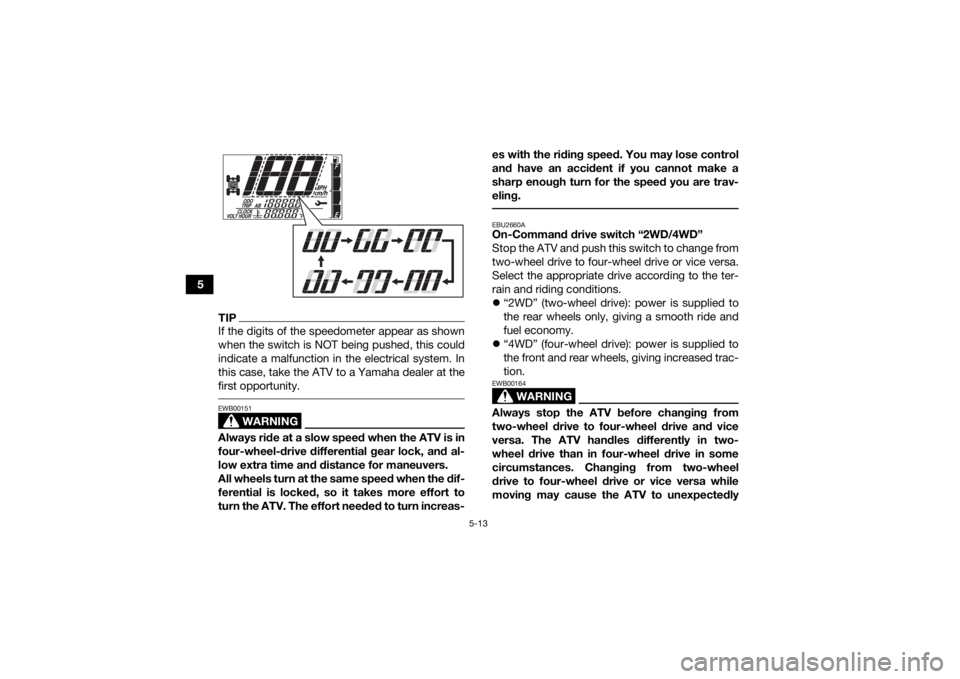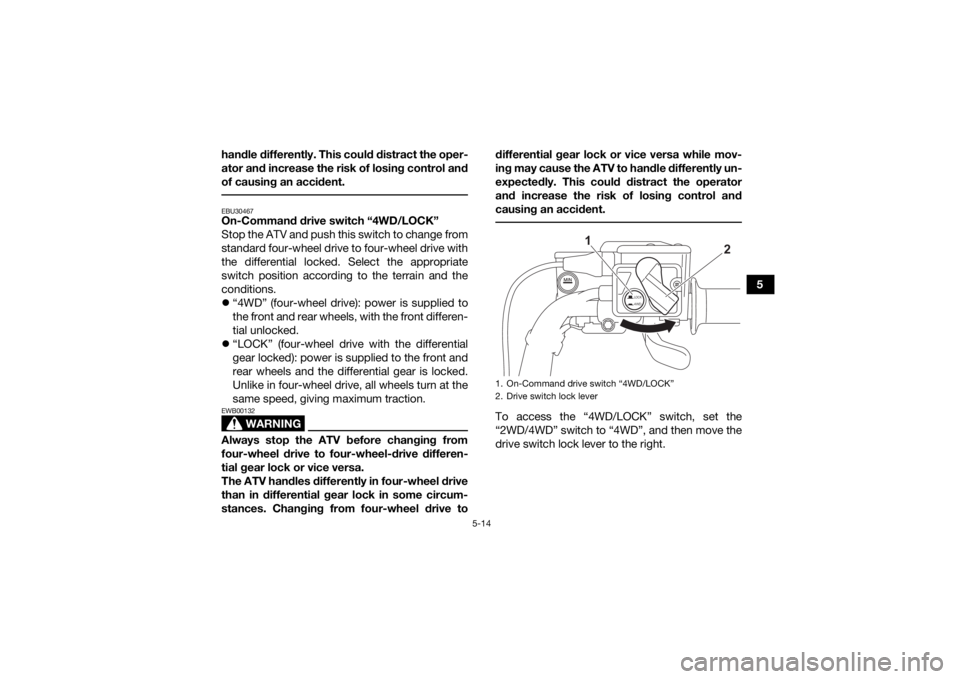2022 YAMAHA GRIZZLY 700 Vin
[x] Cancel search: VinPage 9 of 176

OPERATION ................................................... 7-1Starting the engine ...................................... 7-1
Operating the drive select lever and driving in reverse ....................................... 7-2
Engine break-in ........................................... 7-4
Parking ........................................................ 7-4
Parking on a slope ...................................... 7-5
Accessories and loading ............................. 7-5
RIDING YOUR ATV ........................................ 8-1 GETTING TO KNOW YOUR ATV ................ 8-2
RIDE WITH CARE AND GOOD JUDGMENT .............................................. 8-2
BE CAREFUL WHERE YOU RIDE ............. 8-10
TURNING YOUR ATV................................ 8-13
CLIMBING UPHILL ................................... 8-14
RIDING DOWNHILL .................................. 8-16
CROSSING A SLOPE................................ 8-18
CROSSING THROUGH SHALLOW WATER .................................................... 8-19
RIDING OVER ROUGH TERRAIN ............. 8-21
SLIDING AND SKIDDING.......................... 8-22
WHAT TO DO IF... ..................................... 8-23
PERIODIC MAINTENANCE AND
ADJUSTMENT................................................ 9-1 Owner’s Manuals and Tool Kit .................... 9-2 Periodic maintenance chart: Emission
control system .......................................... 9-3
Periodic maintenance chart: General maintenance and lubrication .................... 9-5
Removing and installing panels ................ 9-10
Checking the spark plug........................... 9-18
Engine oil and oil filter cartridge ............... 9-20
Why Yamalube ......................................... 9-24
Final gear oil ............................................. 9-25
Differential gear oil .................................... 9-27
Coolant ..................................................... 9-29
Cleaning the air filter element ................... 9-37
Cleaning the spark arrester ...................... 9-40
V-belt case drain plug............................... 9-41
Adjusting the throttle lever free play ......... 9-42
Valve clearance......................................... 9-42
Brakes....................................................... 9-42
Checking the front and rear brake pads... 9-43
Checking the brake fluid level .................. 9-44
Changing the brake fluid .......................... 9-45
Checking the front and rear brake lever free play .................................................. 9-46
Adjusting the brake pedal free play .......... 9-47
Axle boots................................................. 9-48
Checking and lubricating the cables ........ 9-49
Checking and lubricating the front and rear brake levers ..................................... 9-49UBLT60E0.book Page 2 Tuesday, July 13, 2021 9:16 AM
Page 10 of 176

Checking and lubricating the brake pedal ....................................................... 9-50
Checking the wheel hub bearings............. 9-51
Checking the stabilizer bushes ................. 9-51
Lubricating the rear knuckle pivots ........... 9-51
Lubricating the steering shaft ................... 9-52
Battery....................................................... 9-52
Replacing a fuse ....................................... 9-56
Replacing a headlight bulb ....................... 9-58
Adjusting a headlight beam ...................... 9-60
Brake/tail light ........................................... 9-61
Removing a wheel ..................................... 9-61
Installing a wheel....................................... 9-62
Troubleshooting ........................................ 9-63
Troubleshooting charts ............................. 9-64
CLEANING AND STORAGE ......................... 10-1 Cleaning .................................................... 10-1
Storage...................................................... 10-2
SPECIFICATIONS ........................................ 11-1
CONSUMER INFORMATION ....................... 12-1 Emissions Certification label (for Europe) ............................................. 12-1
INDEX ........................................................... 13-1
UBLT60E0.book Page 3 Tuesday, July 13, 2021 9:16 AM
Page 24 of 176

3-3
3technique described in this manual on level
ground. Avoid crossing the side of a steep hill if
possible.
Always use proper procedures if you stall or roll
backwards when climbing a hill. To avoid stall-
ing, use the proper gear range and maintain a
steady speed when climbing a hill. If you stall or
roll backwards, follow the special procedure for
braking described in this manual. Dismount on
the uphill side or to a side if pointed straight up-
hill. Turn the ATV around and remount, following
the procedure described in this manual.
Always check for obstacles before operating in
a new area.
Never attempt to operate over large obstacles,
such as large rocks or fallen trees. Always follow
proper procedures when operating over obsta-
cles as described in this manual.
Always be careful when skidding or sliding.
Learn to safely control skidding or sliding by
practicing at low speeds and on level, smooth
terrain. On extremely slippery surfaces, such as
ice, go slowly and be very cautious in order to
reduce the chance of skidding or sliding out of
control.
Never operate an ATV in fast flowing water or in
water deeper than that recommended in this
manual. Remember that wet brakes may have
reduced stopping ability. Test your brakes after
leaving water. If necessary, apply them several
times to let friction dry out the linings.
Always be sure there are no obstacles or people
behind you when you operate in reverse. When
it is safe to proceed in reverse, go slowly.
Always use the size and type of tires specified in
this manual.
Always maintain proper tire pressure as de-
scribed in this manual.
Never exceed the stated load capacity for an
ATV. Cargo should be properly distributed and
securely attached. Reduce speed and follow in-
structions in this manual for carrying cargo or
pulling a trailer. Allow greater distance for brak-
ing.
Do not operate your ATV during darkness un-
less it is equipped with a properly functioning
headlight. Off-road riding is inherently danger-
ous and additionally, off-road trails do not have
streetlights to guide you.
UBLT60E0.book Page 3 Tuesday, July 13, 2021 9:16 AM
Page 26 of 176

3-5
3ungrounded or broken wiring. Visually check
for broken wiring and leaking fuel. Leaking
fuel can be confirmed by the odor of gasoline.
4. Once immediate safety hazards are con- firmed not to exist, you may remove your hel-
met to more closely inspect your vehicle.
Check for external signs of wear, broken
parts, fluid leaks, cracks in the frame, sus-
pension damage, wheel damage, and so on.
Fuel, oil, and coolant usually give off a notice-
able odor.
5. If your vehicle will not restart or if it is unsafe to ride, then turn off all vehicle systems (en-
gine stop switch, main switch, and fuel cock),
and then signal or go for help.
Aftermarket Parts, Accessories, and Modifica-
tions
While you may find aftermarket products similar in
design and quality to genuine Yamaha accesso-
ries, recognize that some aftermarket accessories
or modifications are not suitable because of po-
tential safety hazards to you or others. Installing
aftermarket products or having other modifica-
tions performed to your vehicle that change any of
the vehicle’s design or operation characteristics
can put you and others at greater risk of serious injury or death. You are responsible for injuries re-
lated to changes in the vehicle. Keep the following
guidelines in mind, as well as those found in the
Loading section (page 7-6) when mounting acces-
sories.
Never install accessories that would impair the
performance of your ATV. Carefully inspect the
accessory before using it to make sure that it
does not in any way reduce ground clearance,
limit suspension travel, steering travel or control
operation.
Accessories fitted to the ATV can create insta-
bility due to improper weight distribution.
Bulky or large accessories may seriously affect
the stability of the ATV.
Certain accessories can displace the operator
from his or her normal riding position. This im-
proper position limits the freedom of movement
of the operator and may limit control ability,
therefore, such accessories are not recom-
mended.
Use caution when adding electrical accesso-
ries. If electrical accessories exceed the capac-
ity of the ATV’s electrical system, an electric
failure could result, which could cause a dan-
UBLT60E0.book Page 5 Tuesday, July 13, 2021 9:16 AM
Page 33 of 176

5-4
5
EBU30512Electric Power Steering warning light “EPS”
This warning light comes on when the key is
turned to “ ” (on), and then goes off once the
engine is started. If the warning light remains on or
comes on after the engine is started, the EPS sys-
tem may not be working correctly. When this oc-
curs, have a Yamaha dealer check the EPS
system.
The electrical circuit of the warning light can be
checked by turning the key to “ ” (on). If the
warning light does not come on, have a Yamaha
dealer check the electrical circuit.TIPIf the engine is stopped using the engine stop
switch and the key is in the “ ” (on) position,
the EPS warning light comes on to indicate that
the power assistance for the steering is not
functioning.
If the steering load is too heavy (i.e., excessive
steering use when the ATV is traveling at a slow
speed), the power assist is reduced to protect
the EPS motor from overheating.
EBU38100Four-wheel drive icon “ ”, differential gear
lock icon “ ” and indicator light “ ”
The four-wheel drive icon “ ” comes on when the
drivetrain is set to “4WD” (four-wheel drive).
The differential gear lock icon “ ” and the differ-
ential gear lock indicator light “ ” come on
when the drivetrain is set to “4WD” with the differ-
ential gear locked.TIPDue to the synchronizing mechanism in the dif-
ferential gear case, the four-wheel drive icon
may not come on until the ATV starts moving.
When the On-Command differential gear lock
switch is set to “LOCK” or “4WD”, the “ ” icon
and the “ ” indicator light will flash until the
differential gear is completely locked or un-
locked. Turn the handlebar or start moving to
help the differential lock to engage or disen-
gage.
UBLT60E0.book Page 4 Tuesday, July 13, 2021 9:16 AM
Page 42 of 176

5-13
5
TIPIf the digits of the speedometer appear as shown
when the switch is NOT being pushed, this could
indicate a malfunction in the electrical system. In
this case, take the ATV to a Yamaha dealer at the
first opportunity.
WARNING
EWB00151Always ride at a slow speed when the ATV is in
four-wheel-drive differential gear lock, and al-
low extra time and distance for maneuvers.
All wheels turn at the same speed when the dif-
ferential is locked, so it takes more effort to
turn the ATV. The effort needed to turn increas-es with the riding speed. You may lose control
and have an accident if you cannot make a
sharp enough turn for the speed you are trav-
eling.
EBU2660AOn-Command drive switch “2WD/4WD”
Stop the ATV and push this switch to change from
two-wheel drive to four-wheel drive or vice versa.
Select the appropriate drive according to the ter-
rain and riding conditions.
“2WD” (two-wheel drive): power is supplied to
the rear wheels only, giving a smooth ride and
fuel economy.
“4WD” (four-wheel drive): power is supplied to
the front and rear wheels, giving increased trac-
tion.
WARNING
EWB00164Always stop the ATV before changing from
two-wheel drive to four-wheel drive and vice
versa. The ATV handles differently in two-
wheel drive than in four-wheel drive in some
circumstances. Changing from two-wheel
drive to four-wheel drive or vice versa while
moving may cause the ATV to unexpectedly
UBLT60E0.book Page 13 Tuesday, July 13, 2021 9:16 AM
Page 43 of 176

5-14
5
handle differently. This could distract the oper-
ator and increase the risk of losing control and
of causing an accident.
EBU30467On-Command drive switch “4WD/LOCK”
Stop the ATV and push this switch to change from
standard four-wheel drive to four-wheel drive with
the differential locked. Select the appropriate
switch position according to the terrain and the
conditions.
“4WD” (four-wheel drive): power is supplied to
the front and rear wheels, with the front differen-
tial unlocked.
“LOCK” (four-wheel drive with the differential
gear locked): power is supplied to the front and
rear wheels and the differential gear is locked.
Unlike in four-wheel drive, all wheels turn at the
same speed, giving maximum traction.
WARNING
EWB00132Always stop the ATV before changing from
four-wheel drive to four-wheel-drive differen-
tial gear lock or vice versa.
The ATV handles differently in four-wheel drive
than in differential gear lock in some circum-
stances. Changing from four-wheel drive to differential gear lock or vice versa while mov-
ing may cause the ATV to handle differently un-
expectedly. This could distract the operator
and increase the risk of losing control and
causing an accident.
To access the “4WD/LOCK” switch, set the
“2WD/4WD” switch to “4WD”, and then move the
drive switch lock lever to the right.1. On-Command drive switch “4WD/LOCK”
2. Drive switch lock lever
LOCK4WD
1
2
UBLT60E0.book Page 14 Tuesday, July 13, 2021 9:16 AM
Page 65 of 176

6-6
6
Tire pressure must be checked and set when the
tires are cold. The tire pressure should be the
same on both sides, and must be adjusted ac-
cording to vehicle loading conditions. Set the tire
pressure as specified below.
WARNING! Opera-
tion of this vehicle with improper tire pressure
may cause severe injury or death from loss of
control or rollover. Tire pressure below the
minimum specified could also cause the tire to
dislodge from the rim under severe driving
conditions.
[EWB04120]
OPERATING TIRE PRESSURE (cold):
No cargo or trailer: Front: (Recommended)35.0 kPa (0.350 kgf/cm², 5.0 psi)
Rear: (Recommended) 30.0 kPa (0.300 kgf/cm², 4.4 psi) (BLT5,
BLT8)
35.0 kPa (0.350 kgf/cm², 5.0 psi) (BLTE)
Front: (Minimum) 32.0 kPa (0.320 kgf/cm², 4.6 psi)
Rear: (Minimum) 27.0 kPa (0.270 kgf/cm², 4.0 psi) (BLT5,
BLT8)
32.0 kPa (0.320 kgf/cm², 4.6 psi) (BLTE)
With cargo or trailer: Front: (Recommended)50.0 kPa (0.500 kgf/cm², 7.3 psi)
Rear: (Recommended) 50.0 kPa (0.500 kgf/cm², 7.3 psi)
Front: (Minimum) 45.0 kPa (0.450 kgf/cm², 6.5 psi)
Rear: (Minimum) 45.0 kPa (0.450 kgf/cm², 6.5 psi)
UBLT60E0.book Page 6 Tuesday, July 13, 2021 9:16 AM